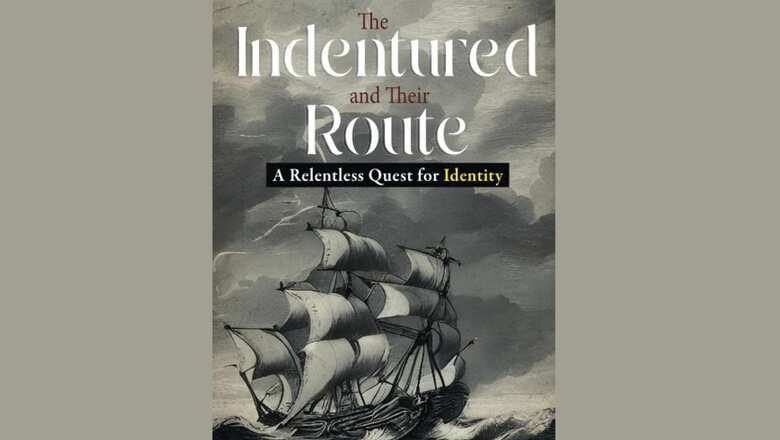
views
Some years ago, I went to Mauritius. A friend, who lives in Mauritius, took me to Aapravasi Ghat (Immigration Depot), declared a UNESCO World Heritage Site in 2006. The history of Indian indenture registers in our peripheral vision. But, until I read Bhaswati Mukherjee’s recent book, The Indentured and Their Route: A Relentless Quest for Identity (Rupa, 2023), I hadn’t read any detailed account.
To quote, “Indenture and its painful origin fall in a grey area in our history. It has largely remained shrouded in the shadows… After slavery was abolished, it was virtually erased from our collective memories, until UNESCO and the African states reminded the world of the Slave Route. Their intention was to ensure that the ashes of forgetfulness do not fall on it again. The moment has come to do the same for indenture.”
What is indenture? “It is a formal agreement binding an apprentice to a master or a contract by which a person agrees to work for a set period for a colonial landowner.” Ostensibly, indenture was a form of migration to enable the indentured to lead better lives outside India and unlike slavery, was characterised by free choice of contract. It was anything but that, and the distinction between slavery and indenture was largely cosmetic. With prohibition on slavery, indenture was a natural substitution.
“Of the 1.3 million Indian indentured labourers who left their motherland from 1834 to 1917, when the Great Experiment ended, only about 21 per cent returned. The rest remained to seamlessly merge into the greater Indian diaspora.”
The British Parliament adopted the Slavery Abolition Act in 1833. “Over one-third of the Indian indentured were sent to Mauritius, another one-third to the Caribbean. The remaining reached South Africa, East Africa, Malaysia and Fiji.” The push was impoverishment in India, especially in eastern parts. “Gandhi was instrumental in campaigning against indenture resulting in British India’s Imperial Legislative Council officially banning indenture in 1917.”
There were other factors at work too. “Fortunately for India, the system was slowing down due to other challenges. There was little enthusiasm for recruitment. The British military, facing a humiliating defeat in Mesopotamia, had stepped up recruitment for the British Indian Army. On 24 December 1915, the Colonial Office instructed that army recruitment had the highest priority.”
As an incentive for helping recruitment drive into the British Indian Army, there seems to have been something called a Kursi Nashin certificate. There is such a certificate floating around on social media, dated 1 July 1887. The certificate was issued by a deputy commissioner and states, “Ram Narain, being an accepted Kursi Nashin of this district, is entitled to a seat when visiting officers and gentlemen.” With a Kurshi Nashin certificate, one had the right to be seated, even when British officers were present. But that’s a separate story.
On indenture, the book says, “The end of indenture in all its forms enabled the formerly indentured to develop into self-sufficient communities. They became like tenant farmers, growing sugarcane for sale and export. Their enslavement and bondage had given way to a pioneering spirit that their descendants would carry on. This was documented by C.F. Andrews on a journey to Fiji in the 1930s. He attributed these positive developments to the efforts of the Arya Samaj and Sanatan Dharma Sabha.”
“The descendants of the indentured built new rainbow nations in the erstwhile plantation colonies as free and independent states. They became the protagonists of a hybrid culture, similar to India but also different. It included the evolution of a creolised culture. Spread across former colonies, it disrupted the erstwhile imperial culture of the Empire. In doing so, they also embraced their new nations as their own. Memories of India slowly faded in the absorption and assimilation of counter-cultures. This made them more resilient and accommodative, more inclined to accept an evolved culture… As the descendants of the indentured came into political and economic power, they traced their roots to India and asserted their cultural identity… Often, a hybrid culture emerged. At other times, it remained intact as with the oral traditions, such as the Bhojpuri language and songs that are still sung in Mauritius, Guyana and Suriname and all over the Caribbean.”
When I visited Aapravasi Ghat, I thought of none of this. Quite a bit has been written on the slave trade now. Unlike that, not much has been written on indentured labour. UNESCO’s International Indentured Labour Route Project states, “Ignorance or concealment of major historical events constitutes an obstacle to mutual understanding, reconciliation and cooperation among peoples”.
The International Labour Route Project centred around Aapravasi Ghat in Mauritius symbolises the story of more than 462,000 indentured labour, the vast majority from India, who were recruited to work on the sugar plantations in Mauritius, after the abolition of slavery. … The International Indentured Labour Route Project will complement the Slave Route Project since both relate to the movement of a mass of people across continents.”
Bhaswati Mukherjee’s book is the beginning, not the culmination, of such research. It’s a useful reminder and exploration of that history, with variations across countries. One hopes there are other such books.

















Comments
0 comment